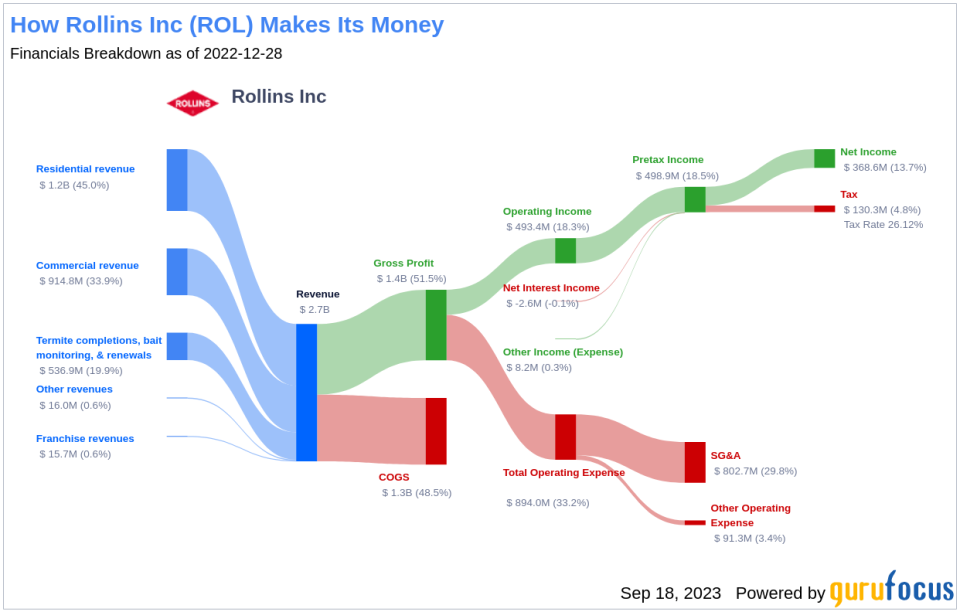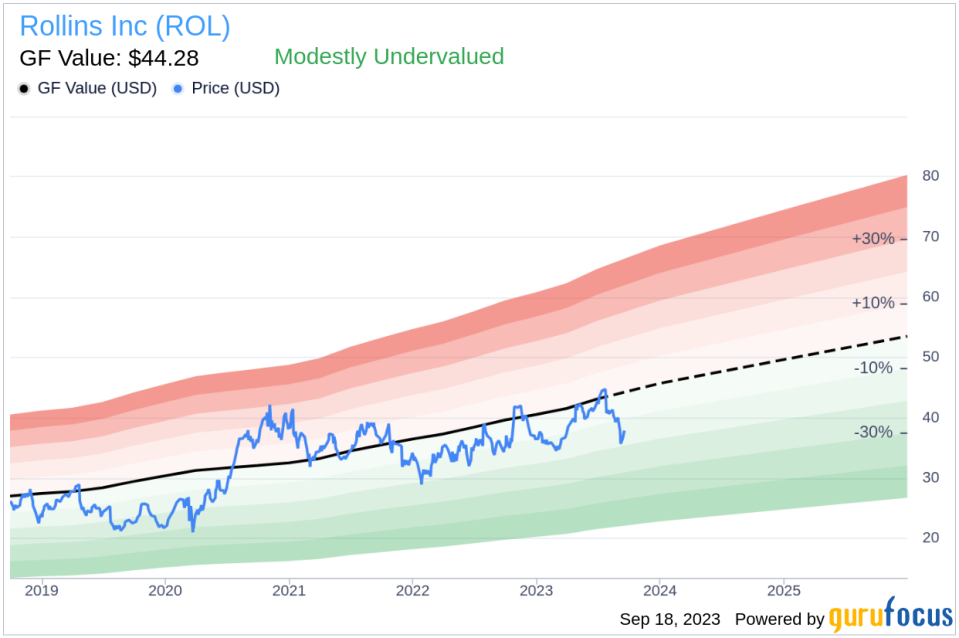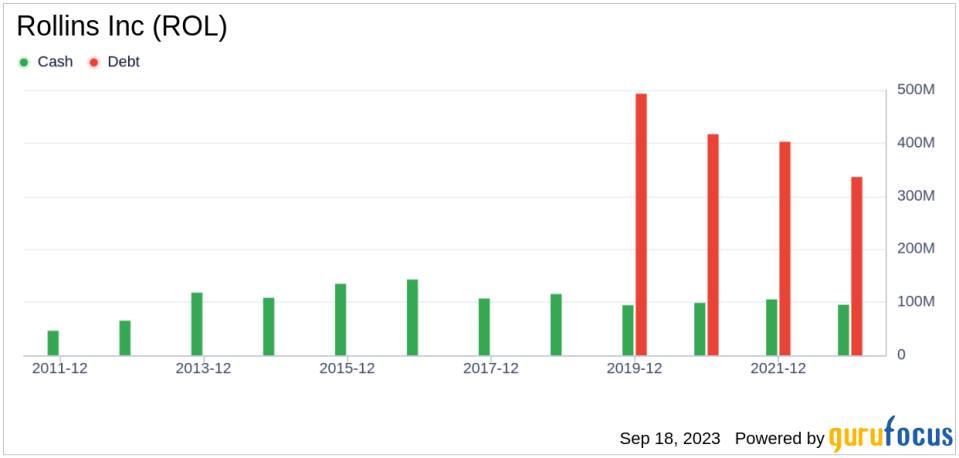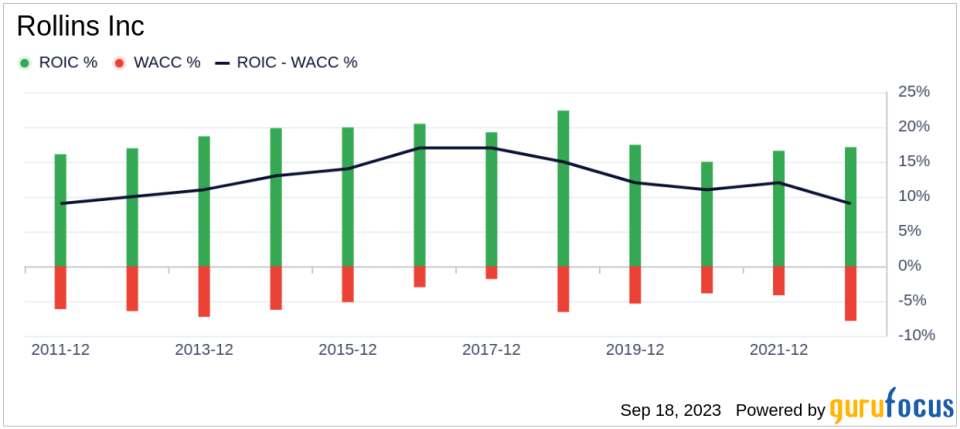Unveiling Rollins (ROL)'s Value: Is It Really Priced Right? A Comprehensive Guide
Rollins Inc (NYSE:ROL) recently experienced a daily gain of 2.42%, but over the past three months, it has seen a loss of 7.72%. The company's Earnings Per Share (EPS) stands at 0.79. Despite these fluctuations, the question remains: Is Rollins (NYSE:ROL) modestly undervalued? This article aims to answer that question by providing a detailed valuation analysis of the company. We invite you to delve into the following analysis for a better understanding of Rollins' intrinsic value.
About Rollins Inc (NYSE:ROL)
Rollins is a global leader in route-based pest-control services, operating across North, Central and South America, Europe, the Middle East, Africa, and Australia. The company is known for its prominent brands, including Orkin, a market leader in the U.S and Canada. Rollins' services are primarily focused on residential pest and termite prevention, owing to its ongoing focus on U.S. and Canadian markets.
At a current stock price of $37.93 per share, Rollins has a market cap of $18.40 billion, and its GF Value, an estimation of fair value, stands at $44.28. This comparison between the stock price and the GF Value paves the way for a deeper exploration of the company's value.
Understanding the GF Value of Rollins (NYSE:ROL)
The GF Value represents the current intrinsic value of a stock, calculated based on historical multiples, a GuruFocus adjustment factor based on the company's past returns and growth, and future estimates of the business performance. The GF Value Line on our summary page provides a snapshot of the fair value that the stock should ideally be traded at.
According to the GF Value, Rollins (NYSE:ROL) appears to be modestly undervalued. This suggests that the long-term return of its stock is likely to be higher than its business growth. The GF Value Line indicates that if the stock's share price is significantly above the GF Value Line, the stock may be overvalued and have poor future returns. Conversely, if the stock's share price is significantly below the GF Value Line, the stock may be undervalued and have high future returns.
Financial Strength of Rollins
Financial strength is a crucial factor when investing in a company as it can help avoid the risk of permanent capital loss. By reviewing the company's financial strength, which includes the cash-to-debt ratio and interest coverage, an investor can make informed decisions. Rollins has a cash-to-debt ratio of 0.25, which ranks worse than 73.08% of 104 companies in the Personal Services industry. However, the overall financial strength of Rollins is 7 out of 10, indicating fair financial strength.
Profitability and Growth of Rollins
Investing in profitable companies, especially those that have demonstrated consistent profitability over the long term, poses less risk. Rollins has been profitable 10 over the past 10 years, with an operating margin of 18.67%, which ranks better than 84.62% of 104 companies in the Personal Services industry. This high profitability indicates a safer investment.
Another crucial factor in the valuation of a company is its growth. Companies that grow faster create more value for shareholders, especially if that growth is profitable. The average annual revenue growth of Rollins is10.1%, which ranks better than 73.74% of 99 companies in the Personal Services industry. The 3-year average EBITDA growth is 19.2%, which ranks better than 75% of 80 companies in the Personal Services industry.
Return on Invested Capital (ROIC) vs Weighted Cost of Capital (WACC)
Comparing a company's return on invested capital (ROIC) to its weighted cost of capital (WACC) is another way to evaluate its profitability. ROIC measures how well a company generates cash flow relative to the capital it has invested in its business. WACC is the rate that a company is expected to pay on average to all its security holders to finance its assets. If the ROIC is higher than the WACC, it indicates that the company is creating value for shareholders. Over the past 12 months, Rollins's ROIC was 17.51, while its WACC came in at 8.31.
Conclusion
In summary, the stock of Rollins (NYSE:ROL) appears to be modestly undervalued. The company's financial condition is fair, and its profitability is strong. Its growth ranks better than 75% of 80 companies in the Personal Services industry. To learn more about Rollins stock, you can check out its 30-Year Financials here.
To find out the high-quality companies that may deliver above-average returns, please check out GuruFocus High Quality Low Capex Screener.
This article first appeared on GuruFocus.




